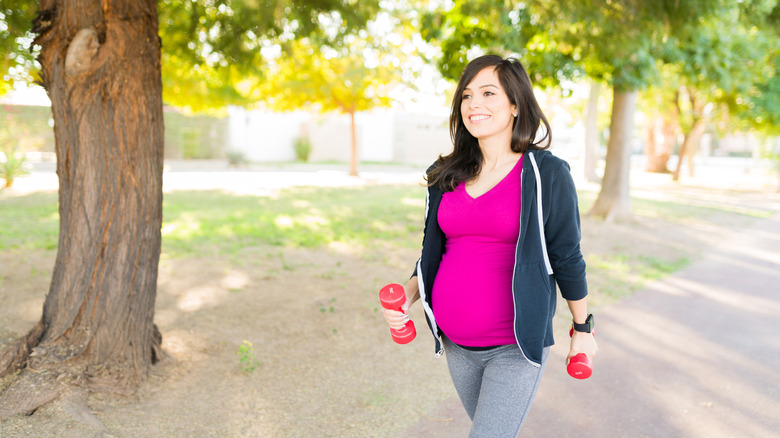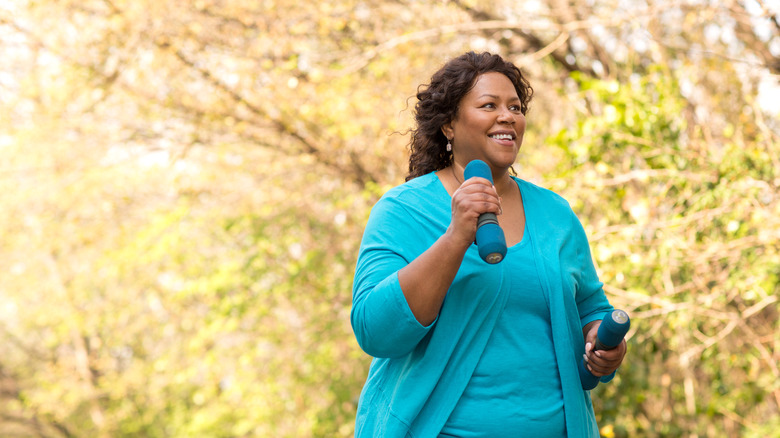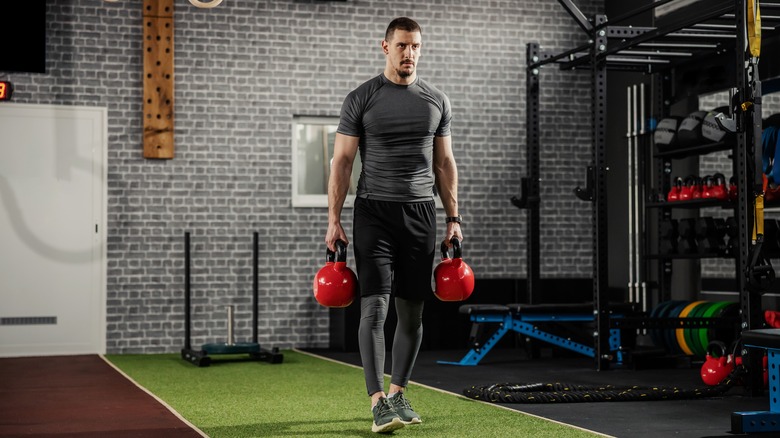Why You Should Consider Adding Farmer's Walks To Your Next Workout
If you're a fan of walking for basic exercise, but looking to crank your walking routine up a notch, meet farmer's walks. Also called loaded walks, or farmer's carry, this exercise has the similar cardio burn walking provides, but it ups the strength training factor by requiring you to carry weights while walking (per Byrdie). These weights can range in size, weight, and type. For instance, Chloe Ting, an instructor at Motosumo, points out to Byrdie that you can use a trap deadlift bar (which is placed on your upper back behind your head), dumbbells, barbells, or kettlebells (all of which are carried by your hands).
Beyond spicing up your walking routine, the farmer's walk exercise has several health benefits as it's a powerful full-body movement. Because this exercise is demanding, it helps improve both endurance and cardiovascular health (via Healthline).
At the same time it also challenges muscle strength. According to a 2019 study, this exercise has the ability to add power and increase strength. What's even more impressive is this functional movement is transferable to other sports ranging from basketball to tennis and more, notes Healthline. Thus it may help improve overall athleticism. This is because the farmer's carry recruits muscles from all over the body including the core, glutes, quads, upper back, traps, lats, and many other muscles.
What muscles does the farmer's walk work?
Even though the farmer's walk works the entire body, some muscle groups are worked more than others. Above all, this exercise targets the core. Since it's a compound ab exercise, it works the deep core muscles such as the transverse abdominis, shares Livestrong. It also works the other abdominal muscles and the erector spinae muscles which support the spine, points out Healthline.
Probably the most obvious muscles being worked during the farmer's walk are those in the lower body. According to Healthline, the muscles targeted here are the quadriceps, hamstrings, glutes, and calves. The quads are responsible for extending and stabilizing the knee, while the hamstrings support knee flexion and stabilization of both the knee and hip. The glutes also aid in the stabilization of the hip joint and support its extension during the movement. Meanwhile, the calves focus on stabilizing the ankle joint while you're walking with weights, points out Healthline.
Nevertheless, this lift heavily targets the upper body (specifically the arms, back, and shoulders). The muscles of the shoulders and upper back work together to stabilize and strengthen the shoulders, explains certified personal trainer Carolina Araujo to Livestrong. Healthline mentions that the triceps, biceps, and forearms are also being activated during the exercise. Even the small intricate hand muscles are targeted during this movement, which consequently leads to a stronger grip (per Barbend).
Mastering a farmer's walk with proper form and technique
Just like other big lifts, there are a couple of things to keep in mind to master the farmer's walk — technique, weight, sets, and reps. Before starting, it's important to choose reps and sets based on how many you can do during the exercise with proper form. Masterclass recommends starting with either two or three sets and performing them in 30 to 60 second intervals. Next, it's important to select the appropriate dumbbell weight. This should also be based on your ability to maintain proper form throughout the lift. In other words, pick a challenging yet comfortable weight.
To perform this exercise, stand with your feet shoulder-width apart and back straight. Inhale, then exhale to reach down to grab the dumbbells as you bend the knees, hips, and ankles (per Masterclass). To stand, deadlift the dumbbells up as you extend through the knees and hips, keeping your back straight (per Healthline).
"Once you stand up, firmly grip the weights and engage all body parts. Squeeze your glutes and quads, suck your belly button to your spine, relax your shoulders, and pinch your shoulder blades together," Brooke Emory, a master trainer at Motosumo, tells Byrdie.
Keep your eyes up, then initiate the farmer's walk by walking forward with a normal stride. After the desired amount of steps (one rep) are reached, "place the weights down the same way you picked them up (reverse deadlift)," Emory tells Byrdie. Rest for at least a minute, then repeat.



